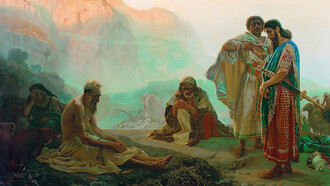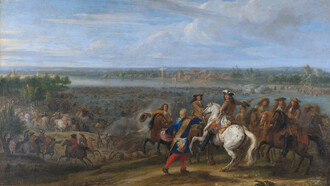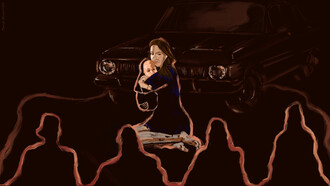Eliza Phelp was born in 1748 to a prosperous Plymouth wine merchant. As his only daughter, she received an adequate education and married Mr Parsons, a turpentine distiller and moved to Stonehouse. During the American Revolutionary War, he lost two of his ships which were seized by the colonists. The family moved to London where their house and goods were destroyed by fire. Mr Parsons subsequently suffered a stroke and died 3 years later, leaving a wife and eight children. Like fellow author Charlotte Smith, she began to write as a way of supporting her family. Eliza Parsons published the Castle of Wolfenbach in 1793.
Like many eighteenth-century gothic novels, Parsons uses the castle or aristocratic house, to imprison the heroine. The building is a symbol of both aristocratic power and wealth. An asset inherited by the eldest son but also a controlling space for the family. When Matilda leaves her uncle’s home and seeks refuge in the Castle of Wolfenbach, she is seeking refuge outside her immediate family. What she is unaware of, is her refuge is a prison for the Countess. Hoeveler argues female gothic is a critique of the family, marriage and church, as it reduces women to a commodity. The family is patriarchal with wives and daughters under the authority of a male head, they are given in marriage based on the acquisition of property rather than sentiment, an authority reinforced by the established church. Thus, the Countess of Wolfenbach is given in marriage to a man she does not love because he is deemed a suitable financial match. When that husband murders the man she loves, both the character and the reader are horrified and helpless. Until she meets Matilda the Countess appears to be the typical passive gothic heroine. Matilda arrives pursued by her uncle, as a desirable female who is under his protection due to family ties. She has taken the initiative to break free of that patriarchal power, driven by a fear for her safety.
Rousseau recommended that children should be brought up in isolation “away from the corruption of society, to become secure in herself that when he enters the public sphere she will be able to withstand its evil influences.” The irony is, evil comes from within the family. Weimar even suggests he has given her a good education and this is the reason she should be grateful. It is only after she goes through puberty that he starts making more personal comments about her appearance which make her uncomfortable. After a trip abroad he returns and presents her with some books of a pornographic nature, which she finds disgusting and his attention both confusing and unwanted. Her distress is not only due to her innocence, but her inability to prevent him from making such advances. She has no knowledge of how to challenge authority, only an inherent feeling that what he is suggesting is wrong.
Parson’s literary contribution is significant as in Weimar she develops Walpole’s idea of usurpation, highlighting the true horror of patriarchal incest. Weimar has killed his brother to inherit the family fortune and Matilda, as his niece, is a threat to that inheritance, unless he consolidates his rights by marrying her. Although women could inherit property if they were the sole survivor with no male heir, any property would be transferred to their husband on marriage. Weimar suggests Matilda was an orphan whom he adopted, only referring to her as his niece for the sake of propriety. By casting doubt on her parentage, he further restricts her marriage prospects and believes she has little choice but to accept his proposal. However, Matilda suggests she would prefer to join a convent than marry him. This would not only preserve her virtue but allows her to exercise an element of personal choice. To and establish legal control, Weimar has to acknowledge she is his niece and although he cannot force her to marry him, he would gain the rights of a guardian. Parsons refers to the French Lettre de Cache, a letter signed by the King for a person’s imprisonment which was not legally enforceable in Britain. This is because Parson’s believed the glorious revolution of 1688 secured rights and freedoms for its people under the law and judicial system not the discretion of the King.
After overhearing his conversation with a servant, Matilda believes her innocence is in danger and this becomes the motivating force for leaving Weimar’s protection and seeking refuge in the castle. Reka Toth argues the gothic has a transforming effect on the heroine because it forces her to leave the patriarchal family and adapt to changing situations. Thus when Matilda meets the Countess at the castle she offers her the protection of her family, the Marquis and Marchioness, who subsequently provide for her and protect her from Weimar. In Otranto, Isabella flees from Manfred and with no male protector seeks sanctuary in a religious institution, something Matilda considers a last resort.
For Walpole the supernatural represented the power of the imagination and a link to spirituality, which enlightenment reason had sought to undermine. Parsons like Clara Reeve and Ann Radcliffe introduced the idea of the supernatural but chose to explain the mysterious noises. The Count requires his wife to create the impression that the rooms are haunted by rattling chains. This is reinforced by Bertha, one of the servants, who is not aware of the Countess’s presence only that there has been a murder in those rooms. For Matilda, this is an opportunity to show her superior reason by dismissing superstition and her insistence on exploring the rooms for herself. It also demonstrates an independent mind and spirit, compared to Walpole’s passive heroines in distress.
Depictions of the aristocracy in the novel fall into two camps. The Marquis and Marchioness along with the Countess are represented as just and honourable, in the way they assist Matilda and seek to protect her from Weimar. Mademoiselle de Fontanelle is the evil gossip monger who does as much as Weimar to blacken Matilda’s name and force her out of the country. The Count De Bouville wishes to marry Matilda but she resists on the grounds that she does not know her true heritage and it would not be fair for him to ruin his reputation. When she finally discovers her mother, the Countess Berniti, is still alive, then Matilda consents to marry the Count.
Parsons not only highlights the idea of female imprisonment and male patriarchy but adds the unique problem of incest to maintain power and authority within the family. Like Radcliffe, her heroine is not passive but actively seeks to shape her own life, spurred on by a villain who seeks to undermine her innocence and deprive her of future happiness.















